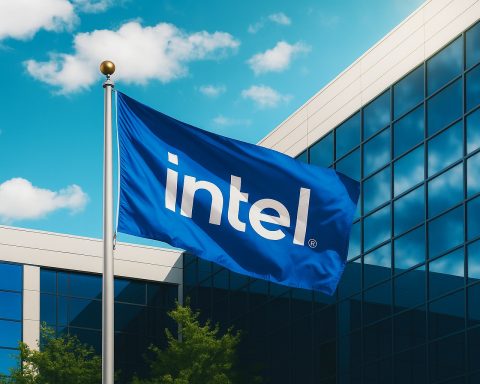Coinbase Global, Inc. (NASDAQ: COIN) is back in the spotlight today as its share price drops sharply alongside a broader crypto sell‑off, just as the company reshapes its legal home, battles U.S. banks over stablecoin rewards, and rolls out new savings and token‑sale products across the U.S., UK and Singapore.
COIN stock today: sharp pullback in a brutal crypto session
Coinbase shares recently traded around $283, down roughly 7% on the day, after closing Thursday at $304.08, putting the exchange’s market value in the mid‑$70 billion range. [1]
That weakness comes amid a synchronized slide across digital assets. As of Friday morning (UTC), total crypto market capitalization has fallen 5.6% to about $3.38 trillion, with Bitcoin down 6.2% to ~$97,000 and Ether off 9.2% to ~$3,200. Almost all of the top 100 coins are in the red, according to Cryptonews. [2]
Macro pressure is part of the story: analysts point to a stronger U.S. dollar, higher Treasury yields and ETF outflows—U.S. spot Bitcoin ETFs saw roughly $870 million in net redemptions yesterday, while ETH products shed about $260 million. [3]
At the same time, stock‑specific headlines are amplifying volatility for COIN, including a controversial move to leave Delaware, unusually heavy insider sales, and a high‑stakes regulatory fight over stablecoin yields.
Texas over Delaware: Coinbase joins the corporate “Dexit”
One of the biggest structural moves shaping investor sentiment is Coinbase’s decision to reincorporate from Delaware to Texas.
On November 12, Coinbase disclosed in an SEC filing that it plans to abandon Delaware as its legal domicile and move to Texas, joining a small but growing list of large companies leaving the state. [4]
In an op‑ed on the company’s blog, Chief Legal Officer Paul Grewal said Coinbase is “leaving Delaware and reincorporating in Texas” because the Lone Star State has become a more attractive hub for innovative companies, while Delaware courts have become less predictable and more hostile to boards. [5]
Texas has aggressively courted blockchain and fintech firms with:
- Lighter regulation and specialized business courts
- A political climate generally friendlier to digital assets
- Lower taxes and operating costs compared to the U.S. coasts [6]
CryptoDaily and other outlets frame the move as part of a broader “Delaware exodus,” noting that Coinbase—one of the largest public crypto firms in the U.S.—would be among the biggest names yet to shift its legal base to Texas, following moves by Tesla and other high‑profile companies. [7]
For shareholders, the reincorporation raises practical questions:
- Short term: legal and governance uncertainty during the transition, and potential litigation risk as corporate law changes.
- Medium term: a legal environment that may be more sympathetic to crypto innovation and tokenization, which could benefit Coinbase’s ambitious product roadmap.
The trillion‑dollar fight over stablecoin rewards
At the same time, Coinbase has thrown itself into a regulatory brawl that could reshape one of its fastest‑growing businesses: stablecoin rewards.
GENIUS Act: stablecoins can be “digital cash,” but who can pay yield?
The GENIUS Act, passed in July 2025, brought U.S. dollar stablecoins into a federal framework, requiring 100% reserves, audits, and bankruptcy protections for holders. It explicitly bars stablecoin issuers from paying interest, to keep tokens behaving like cash rather than securities. [8]
However, the law doesn’t clearly prohibit exchanges or intermediaries—like Coinbase or PayPal—from offering rewards on customers’ stablecoin balances. That gap has become the focal point of an intense lobbying battle:
- Banking associations are urging regulators to interpret the law broadly, arguing any yield‑like rewards on stablecoins—no matter who pays them—should be treated as interest. One widely cited estimate warns up to $6.6 trillion in bank deposits could migrate into yield‑bearing stablecoins over time. [9]
- Coinbase and other crypto firms counter that Congress deliberately limited the ban to issuers and preserved room for third‑party rewards. They warn that expanding the prohibition now would “rewrite” the statute, undermine competition and penalize ordinary savers. [10]
Today’s news flow shows Coinbase going fully on offense:
- A detailed explainer from DisruptionBanking notes that Coinbase currently offers around 4% annual rewards on USDC holdings, on par with or better than many traditional savings accounts. [11]
- A fresh CoinCentral article describes Coinbase “intensifying its confrontation” with major U.S. banks after they asked regulators to shut down merchant rewards and cashback linked to stablecoin payments, which banks argue are disguised interest. [12]
- Coverage from outlets like XT.com and Coinfomania highlights Coinbase’s rhetoric, calling the bank push “un‑American” and “anti‑innovation,” and pointing out that banks fear losing $180 billion a year in credit‑card fee revenue if low‑fee stablecoin payments go mainstream. [13]
An AI‑driven analysis from AInvest estimates that stablecoin‑related services already account for nearly 20% of Coinbase’s revenue, and argues that regulatory clarity on rewards could be a major catalyst for both the company and the wider crypto credit market. [14]
For COIN investors, the takeaway is straightforward:
The rules around stablecoin yields are now a central earnings risk—and opportunity—for Coinbase.
From Singapore to the UK: Coinbase looks more like a crypto bank
While it battles banks on one front, Coinbase is also starting to look like one.
Coinbase Business launches in Singapore
On November 12, Coinbase unveiled “Coinbase Business” in Singapore, the platform’s first international expansion of its all‑in‑one crypto operating account for startups and SMBs. [15]
According to Coinbase’s own blog, the Singapore offering bundles: [16]
- Trading & treasury: businesses can buy, sell and manage crypto directly from a single operating account.
- Global USDC payouts: near‑instant cross‑border payments to vendors and remote workers in USDC at lower fees than traditional wires.
- Payment links: one‑click invoices paid in crypto, typically at a 1% merchant fee, undercutting many card networks.
- Integrated yield & accounting: USDC balances can earn rewards, with direct reconciliation to tools like QuickBooks and Xero.
- A partnership with Standard Chartered to provide real‑time SGD transfers, anchoring the product in the local banking system. [17]
The launch builds on Coinbase’s role in Singapore’s MAS BLOOM initiative, where the firm is helping test “agentic payments” and programmable settlement for digital assets. [18]
UK savings accounts with ClearBank
In the UK, Coinbase has quietly taken another bank‑like step. A new deal with ClearBank, announced today, will enable savings accounts for UK customers via ClearBank’s embedded banking platform—reportedly the first time a crypto‑native exchange has helped launch savings products of this type in the UK. [19]
A fintech newsletter from This Week in Fintech notes that Coinbase has rolled out a UK savings account paying around 3.75% AER (variable) on GBP balances, with instant deposits and withdrawals and funds safeguarded under the country’s deposit protection regime. [20]
Together, these moves reinforce a narrative that Coinbase is evolving from a pure trading venue into something closer to a crypto‑powered neobank or super‑app, competing with both challenger banks and legacy card networks. [21]
Prediction markets and custody: Kalshi chooses Coinbase
Today’s headlines also include a new institutional partnership: regulated prediction‑market operator Kalshi has selected Coinbase Custody to safeguard the USDC that powers its event‑based contracts. [22]
Messari and Coinbase’s own “Kalshi” product post frame the deal as a trust signal for Coinbase’s institutional custody stack, tying stablecoins directly into a regulated prediction‑market venue at a time when tokenized betting and derivatives are under close scrutiny. [23]
Token sales and early‑access listings: Coinbase’s new launch pad
Another major strategic pillar this week is Coinbase’s new token‑sales platform, which lets retail users buy tokens before they list—something U.S. investors haven’t been able to do at scale since the 2017–2018 ICO boom.
In a November 10 blog post, Coinbase describes the platform as an “end‑to‑end token sales” solution that: [24]
- Uses a request‑window + allocation algorithm designed to “fill from the bottom” so smaller orders are more likely to be filled, limiting whale concentration.
- Penalizes fast flippers: users who dump tokens shortly after they list can receive lower allocations in future sales, aligning incentives with long‑term community members.
- Requires issuer disclosures, lock‑ups and post‑sale restrictions, including a six‑month ban on insider OTC sales without Coinbase approval.
- Charges no fees to buyers, only a fee to token issuers based on the USDC raised.
Reuters and fintech newsletters emphasize that the platform may effectively revive U.S. retail participation in public token offerings, but with more guardrails than the old ICO era. [25]
Coinbase says it will host roughly one token sale per month, with the first sale scheduled for November 17–22, positioning itself as both an exchange and a primary‑market gateway for new crypto assets. [26]
Heavy insider selling and hedge funds trimming COIN stakes
Today’s price weakness is also being filtered through a governance and ownership lens. Several reports highlight significant insider and institutional selling in recent months:
- CoinCentral and Blockonomi both point to about $17–18 million in insider share sales disclosed in recent SEC filings, coinciding with the Texas reincorporation announcement and new product launches. [27]
- A MarketBeat alert today notes that Fox Run Management L.L.C. slashed its COIN position by 76.2% in Q2, selling 2,715 shares and keeping just 846 (~$297,000). [28]
- A separate MarketBeat piece earlier this week reported that KBC Group NV cut its stake by nearly 89%, while detailing that insiders including CFO Alesia Haas and co‑founder Fred Ehrsam collectively sold more than 640,000 shares (~$200M) over the last quarter, even though insiders still own roughly 17–18% of the company. [29]
Despite that selling, hedge funds and institutions collectively own close to 69% of Coinbase stock, and MarketBeat’s compiled analyst ratings still peg COIN as a “Moderate Buy” with an average price target around $400 per share—well above today’s levels. [30]
For some investors, heavy insider selling near multi‑year highs is a red flag; for others, the analyst support and institutional base underscore confidence in Coinbase’s long‑term positioning.
Q3 earnings backdrop: profits, diversification and volatility
It’s worth remembering that today’s sell‑off follows a strong Q3 earnings print at the end of October:
- Coinbase reported revenue of about $1.87 billion, up over 55% year‑on‑year, beating Wall Street estimates of roughly $1.77 billion.
- EPS came in around $1.44 versus $1.04 expected, showing Coinbase can be solidly profitable in a bullish market. [31]
- Coindesk highlights that transaction revenue hit $1 billion, but a growing share now comes from subscriptions and services, including stablecoins, derivatives and institutional products. [32]
New partnerships—like Coinbase Asset Management’s deal with Apollo to build stablecoin‑based credit strategies—fit this theme of diversifying away from pure retail trading fees toward recurring, institutional and yield‑linked revenue streams. [33]
However, as today demonstrates, that diversification doesn’t eliminate Coinbase’s sensitivity to crypto prices or regulatory headlines; it simply changes the mix of risks.
How Coinbase fits into today’s crypto sell‑off
Even as prices fall, on‑chain data and market commentary show that big players may be buying the dip. A TradingView‑sourced analysis this morning pointed out that Cumberland, Galaxy Digital, Coinbase Institutional and another whale collectively sent roughly 4,000+ BTC (over $400 million) to Anchorage Digital in just nine hours—an indication of large, possibly long‑term allocations being made while retail sentiment turns fearful. [34]
That duality—spot‑price pain vs. long‑term accumulation—is reflected in Coinbase’s own story:
- Short term, COIN trades like a high‑beta proxy on crypto, selling off as ETFs see outflows and macro jitters rise. [35]
- Long term, the company is positioning itself at the center of stablecoins, tokenization, prediction markets and crypto‑native savings products in multiple jurisdictions. [36]
An opinion piece on The Motley Fool today even highlights Coinbase CEO Brian Armstrong as one of the prominent voices arguing that Bitcoin could reach $1 million within a decade, underscoring management’s conviction that we’re still early in the adoption curve—even if the stock is currently whipsawed by macro and regulatory uncertainty. [37]
Key things COIN investors should watch next
Nothing here is investment advice, but based on today’s news, here are the main catalysts and risk factors to monitor over the coming months:
- Stablecoin rewards rules (GENIUS Act implementation)
- Will regulators side more with bank lobbies or Coinbase/Stand With Crypto on whether third‑party rewards are allowed?
- A restrictive interpretation could hit a revenue stream that’s already material; a permissive one could turbo‑charge Coinbase’s USDC‑centric strategy. [38]
- Finalization of the Texas reincorporation
- How smoothly does the legal transition occur, and do any shareholder or regulatory challenges emerge?
- Does Texas actually deliver on promises of clearer courts and a more accommodating environment for digital asset innovation? [39]
- Adoption of Singapore Business and UK savings products
- Do startups and SMBs in Singapore meaningfully adopt Coinbase Business for USDC payroll and vendor payments?
- How quickly do UK users move money into the new ClearBank‑powered savings account, and does it attract new customers or mainly deepen existing relationships? [40]
- Token sales platform traction
- Investor demand for the first token sale (November 17–22) and any follow‑on listings will be an early test of whether Coinbase can become the default launch pad for compliant token offerings. [41]
- Insider and institutional flows
- Do insider sales moderate now that the Texas move and new products are public, or do executives continue to sell into strength?
- Do hedge funds like KBC and Fox Run rebuild positions if the stock pulls back, or stay on the sidelines? [42]
- Macro and ETF flows
- Continued volatility in Bitcoin ETFs and interest‑rate expectations will likely keep COIN trading with high beta to crypto for the foreseeable future. [43]
Bottom line
On November 14, 2025, Coinbase finds itself at a crossroads:
- Stock down, but still up double‑digits year‑to‑date. [44]
- Legal home changing from Delaware to Texas. [45]
- Business model broadening from exchange fees to stablecoin yields, savings products, token sales and B2B crypto banking. [46]
- Regulation tightening, especially around stablecoins, even as institutional adoption deepens. [47]
For traders, COIN remains a highly leveraged bet on crypto market sentiment. For long‑term investors, today’s flurry of announcements—Texas, Singapore, the UK, Kalshi, token sales and the stablecoin fight—underscore that Coinbase is trying to position itself not just as a crypto exchange, but as a core piece of the next‑generation financial infrastructure.
As always, anyone considering COIN or crypto exposure should do their own research, understand their risk tolerance, and remember that both the assets and the companies building around them can be extremely volatile.
References
1. coincentral.com, 2. cryptonews.com, 3. cryptonews.com, 4. www.reuters.com, 5. www.coinbase.com, 6. www.reuters.com, 7. cryptodaily.co.uk, 8. www.disruptionbanking.com, 9. www.disruptionbanking.com, 10. www.disruptionbanking.com, 11. www.disruptionbanking.com, 12. coincentral.com, 13. www.xt.com, 14. www.ainvest.com, 15. www.coinbase.com, 16. www.coinbase.com, 17. www.coinbase.com, 18. www.coinbase.com, 19. www.crowdfundinsider.com, 20. www.thisweekinfintech.com, 21. www.thisweekinfintech.com, 22. blockonomi.com, 23. messari.io, 24. www.coinbase.com, 25. www.reuters.com, 26. www.coinbase.com, 27. blockonomi.com, 28. www.marketbeat.com, 29. www.marketbeat.com, 30. www.marketbeat.com, 31. www.coindesk.com, 32. www.coindesk.com, 33. www.crowdfundinsider.com, 34. www.tradingview.com, 35. cryptonews.com, 36. www.coinbase.com, 37. www.fool.com, 38. www.disruptionbanking.com, 39. www.reuters.com, 40. www.coinbase.com, 41. www.coinbase.com, 42. www.marketbeat.com, 43. cryptonews.com, 44. coincentral.com, 45. www.reuters.com, 46. www.coinbase.com, 47. www.disruptionbanking.com










